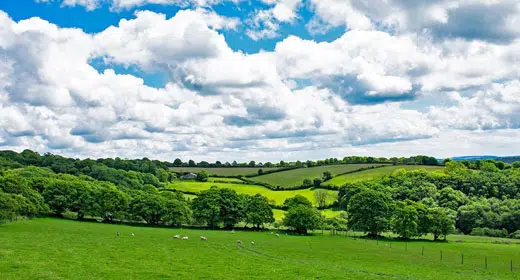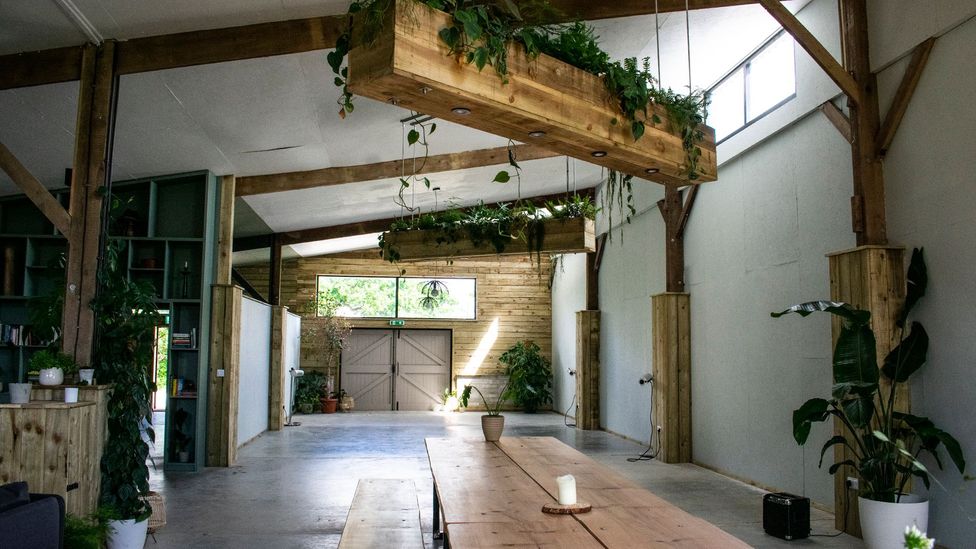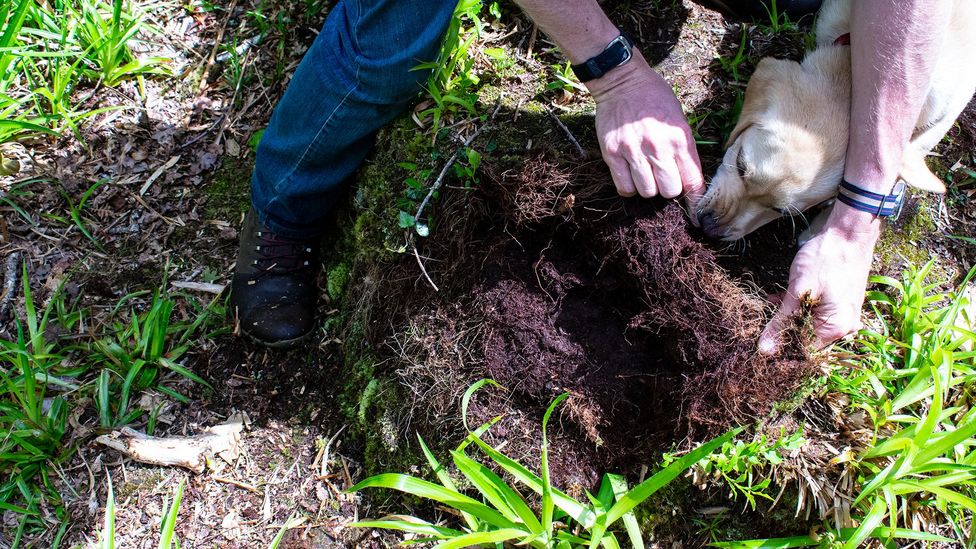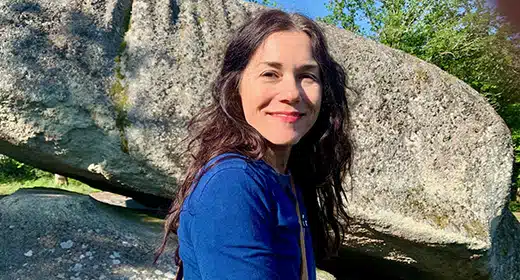by Amanda Ruggeri: Merlin and Lizzie Hanbury-Tenison are not your usual farmers. Their mission is to honour an ancient woodland, restore their land’s ecosystems and share its restorative powers.
 I’d never seen a pig quite like Gloria. Black and hairy, with floppy ears the size of dinner plates, she almost knocked me over when she nuzzled me with her snout. As a Large Black, Gloria is a rare breed – once common throughout South West England, today there are only around 300 breeding sows of her kind in the UK.
I’d never seen a pig quite like Gloria. Black and hairy, with floppy ears the size of dinner plates, she almost knocked me over when she nuzzled me with her snout. As a Large Black, Gloria is a rare breed – once common throughout South West England, today there are only around 300 breeding sows of her kind in the UK.
This is a shame. “Pigs like Gloria are a vital part of a healthy ecosystem,” said her owner Merlin Hanbury-Tenison. He pointed to a muddy puddle in the field, unremarkable to the untrained eye. “She turns the soil and creates wet patches. That wouldn’t be there otherwise. And that creates micro-habitats that insects can find a home in, where seeds can start to break through, where trees can start to grow.” More common white pigs, which are not native to this area, don’t have the heft – Large Black sows weigh around 300kg – to rootle like a Large Black.
Then he gestured to the rolling hills in the distance. The patchwork of fields, their clipped grass neatly divided by hedgerows, looked like the vision of quintessential English beauty.
“That’s a green desert,” he said. “There’s nothing living in it. We really need the chaos, the mosaic, the messiness that a pig like Gloria can bring to the natural world.”
His view of the surrounding countryside might be tinged with hyperbole. But he has a point: centuries of farming in Britain has transformed the landscape, not always for the better. Along with his wife Lizzie, Merlin is on a mission to bring that “messiness”, and biodiversity, back – starting with his home, Cabilla.
A 300-acre farm set in the rugged, granite-hewn landscape of Cornwall’s Bodmin Moor, Cabilla has been in Merlin’s family since his father bought it in 1960. When Merlin and Lizzie took over in 2018, they wanted to shift Cabilla in a more sustainable direction. To them, Cabilla is more than a farm. It is an intricate network of ecosystems made up of fields, river and an ancient woodland that is one of the last remaining temperate rainforests in Europe. Their aim is to restore the land, create jobs – and even help people become healthier.

“Pigs like Gloria are a vital part of a healthy ecosystem,” said her owner Merlin Hanbury-Tenison (Credit: Amanda Ruggeri/BBC)
So far, they’ve reintroduced beavers, planted 100,000 native oaks, seeded wildflowers, become an official native dark honeybee reserve, and worked with more than 20 university researchers to measure the impacts of Cabilla’s rewilding on the ecosystems, as well as the benefits of nature on human wellbeing. And this, they say, is only the start. Their ultimate mission: to make Cabilla a farm that lasts for 1,000 years, a philosophy that owes a debt to the indigenous Seventh Generation Principle.
“Growing up on a farm, you always have drilled into you that the grassland out there on the other side of the valley, that’s your business. That’s profitable. You grow grass, you feed animals, you sell the milk or the meat of those animals,” Merlin said. “The woodland, that’s a bit of an inconvenience. If you could, you’d cut it down and get more grassland, and a few more animals.
“But I realised that I was spending all my time in the woodland and the grassland wasn’t of interest to me. And that’s when I went, ‘Maybe we’ve got this the wrong way around. Maybe, maybe we should be focusing slightly differently.'”
“Maybe we’ve got this the wrong way around. Maybe, maybe we should be focusing slightly differently”
Farming is not unusual in this part of the world. Despite making up just 10% of England’s land area, the South West is home to almost 20% of its farmland. Even in the hardy, difficult-to-cultivate uplands of Bodmin Moor, agriculture goes back millennia – farmhouses and field boundaries dating back 3,500 years have been found. But being a farmer is tough and could get tougher, particularly here, where farms are smaller than the UK average and have largely relied on EU subsidies now being phased out post-Brexit. Climate change is a growing challenge, while decades of intensive agricultural practises have left the soil depleted.
Cabilla has not been immune. When Merlin’s father, well-known British author and explorer Robin Hanbury-Tenison, bought the farm in 1960, it had cows, sheep and hens; it produced oats, wheat, barley, cabbages and turnips. Eight people worked full time. But with the rising emphasis on efficiency in the UK’s agricultural sector, the farm started to focus on beef and sheep exclusively – mitigating the need to work the fields or harvest produce – and Cabilla went from eight full-time employees to none.
In contrast, Merlin and Lizzie want Cabilla’s current approach to showcase what a sustainable farm can look like today. They see the environmental restoration and farm’s productivity as going hand-in-hand.

Instead of keeping cows in fields, they want to move native cattle through the woodland using a no-fence GPS system (Credit: Amanda Ruggeri/BBC)
Take their plan for cows. Instead of keeping them in fields, they want to move native cattle through the woodland using a no-fence GPS system. The approach, which is based on an ancient practice called silvopasturing, is healthier for cattle, better for carbon sequestration and helps biodiversity.
“We will still be producing meat – more meat, better, healthier meat. Just not on grass fields, which is not where a cow should be anyway,” said Merlin. “Chickens aren’t designed to live in small cages and sheds. Pigs aren’t designed to live in small metal cages in massive feedlots. We need to take these animals, get them back to what they should normally be in terms of their development and their physiology, and then put them back in their natural environment so they can benefit the natural world.”
As well as the environmental initiatives, Merlin and Lizzie have opened the estate up to visitors who want to get away from it all, with retreats and overnight stays featuring activities like outdoor yoga, sound baths, wild swimming and nature walks. I followed Merlin into a barn smelling of fresh oak. A year ago, there was cattle slurry on the floor. Now, it’s a spare, modern space with soaring ceilings, hanging plants and an open kitchen for making mocktails or following a foraged-food demonstration. Visitors can stay in either the estate’s cottage or in what Merlin and Lizzie call the “Koyts“, A-frame cabins inspired by Cornish “quoits” (or dolmens) that Neolithic peoples used for spiritual purposes. Through large windows, they can stargaze, a benefit of Bodmin Moor’s protected Dark Sky status.
The idea to open Cabilla to visitors came from how Lizzie says the land has helped heal her and Merlin. When I spoke to her, she was 33 weeks pregnant. Her older daughter played in their house as we sat at a table outside, overlooking the thick forest and a cloud-dappled blue sky. It seemed the picture of idyllic Cornish country living.

The barn has been redesigned into a spare, modern space with soaring ceilings, hanging plants and an open kitchen (Credit: Amanda Ruggeri/BBC)
But life hasn’t always been like this. For nearly a decade, Lizzie and Merlin were living in London, where he worked as a management consultant and she held a senior marketing position. They would come to Merlin’s family’s farm as a respite from the city grind. “Every time we’d get off the train, it would be like this physical release of tension,” Lizzie said. “I literally had to come down to Cornwall to sleep.”
Then, in 2018, Lizzie had a late-stage miscarriage, her first of two lost pregnancies, and came to Cabilla – specifically its woodland – to recover. She and Merlin went on daily walks through the trees where the restorative power of “forest bathing” quickly became apparent.
“Something really amazing happens when you slow your entire life down and you start looking at little things in nature,” Lizzie said. “You start to observe things in a really different way. And you start to appreciate things like beauty, and tiny bits of moss growing on a tree, and seeing campion [a pink wildflower] pop up when it hadn’t been there a week before. It’s healed us in so many ways.”
The trees helped Merlin, too. He was dealing with PTSD from serving three tours in Afghanistan in a front-line combat role. “I remember going through training and being told that it can take up to 10 years for the symptoms of PTSD to start to manifest. And I remember, as a young, foolish man at the time, thinking, ‘That’s ridiculous’,” he said. “My first tour of Afghanistan was in 2007. I had a breakdown in 2017, almost 10 years to the day.” The woodland walks proved crucial to his recovery.
After their experiences, Merlin and Lizzie knew they couldn’t keep Cabilla private anymore. They wanted to share its potential wellness benefits with others. As well as opening it up to paying guests, they are yet to turn down a request by a member of the public for a woodland walk, although they’re mindful of limiting numbers to protect the vulnerable habitat. Merlin also has just set up a partnership with the US military, which will use Cabilla for retreats for veterans dealing with PTSD or moral injury. And Lizzie, who also experienced postnatal anxiety and insomnia after her daughter’s birth, is thinking about how to make Cabilla accessible for women dealing with miscarriage or birth trauma.

Researchers have established that Cabilla’s woodland is 3,664 years old, give or take 29 years (Credit: Amanda Ruggeri/BBC)
Now, I plunged into the woods after Merlin, one of the family’s six golden Labradors and her puppy Ella nipping at our heels. Thigh-high ferns stretched green and thick above the last of the season’s bluebells. It didn’t take long to realise that Cabilla’s woodland isn’t just sacred to the Hanbury-Tenisons for emotional reasons. It’s also an ecological gem.
For one, it’s a temperate rainforest. Rich with rare fungi and lichen, as well as the animals those plants help support, from wood warblers to brimstone butterflies, this kind of woodland is even more threatened than its tropical counterpart. Around 50% of the planet’s tropical rainforest has been cut down; in Europe, 98% of the temperate rainforest has gone.
It is also ancient: researchers have established that Cabilla’s woodland is 3,664 years old, give or take 29 years. That doesn’t mean that the individual trees are millennia old, but rather that the forest has been left to its own devices for that amount of time – something that is both incredibly rare and special. A particular ecological alchemy arises from the centuries of soil, growth and decay; in the UK, ancient woodland is home to more threatened species than any other kind of forest.
One of the most extraordinary things, though, is how the trees “communicate”. Trees connect to one another underground through networks of fungi, through which they pass on everything from nutrients to chemical alarm signals, warning other trees of danger. The older the forest, the more established these networks are. Which is why in Cabilla, for example, the oak trees all drop their seeds at precisely the same time – over a one-week period every three to five years.
“Trees not only share water, resources, sugars, but can also share messages, share knowledge. Trees can communicate. They can pass multi-generational knowledge downwards. And whereas before we just cut a tree down and think it was just an inanimate object, now we know they almost have personalities,” Merlin said, citing the work of scientist Suzanne Simard. “I think they do have personalities.”

The trees around the mother tree are its literal relatives, offspring created from her acorns and nurtured by her nutrients (Credit: Amanda Ruggeri/BBC)
We stopped in the shade of one particularly lovely specimen, with gnarled limbs that twisted upwards. “She’s my favourite. That’s my girl,” Merlin said. “That’s the mother tree.” It wasn’t a mere nickname. The trees around it are its literal relatives, offspring created not only from the mother tree’s acorns but nurtured by her nutrients and her communication signals.
The mother tree even was nurturing a different species. A baby rowan rose from one of the limbs, its roots sucking water from the mother oak. “An oak tree is not a single organism. It’s a community,” Merlin said fondly. “A single oak tree can support up to 600 species living on it at any one time. Oaks are cities; they are towns.” The same isn’t true of other, non-native trees, which even can harm the native wildlife they’re meant to protect.
Among the Hanbury-Tenisons’ main aims is to triple the size of the rainforest, using native species, from 100 to 300 acres. They’ve started by raising 100,000 baby oaks in a nursery until they’re strong enough to plant in the forest.
As we walked, Merlin stopped every few feet to point out something I’d have missed. A type of lichen called Old Man’s Beard, one of 14 native UK lichen species, that only grows where the air is pure. In an old badger hole, a patch of faintly glowing Goblin’s Gold, a bioluminescent moss that once confused Cornish miners looking for precious metal. Even the fungal mycelium itself, the “wires” of the network connecting the trees, which lies just under the soil like a fibrous mat covered in dirt.

Fungal mycelium, the “wires” of the network connecting the trees, lies just under the soil like a fibrous mat covered in dirt (Credit: Amanda Ruggeri/BBC)
Left alone, I might even have walked past the beaver dam. This is another rare sight for the UK, where Eurasian beavers, a native animal, went extinct in the 16th Century. Cabilla released their first, Sigourney Beaver, into the River Bedalder in July 2020; she was followed that September by a male, Jean-Claude Van Dam. This year, the first baby beavers were born on Bodmin Moor in more than 400 years.
Towards the end of our walk, we stopped at the top of a 200m tall tor, one of the moor’s signature granite outcrops. Thickly covered in oak and ash trees and ferns, the tor hides a secret ferreted out by a visiting archaeologist: a 4,000-year-old stone circle.
But there was something odd about it, the archaeologist told the Hanbury-Tenisons. These formations were usually built near water or an easily defensible position. Cabilla’s tor offers neither. All he could figure was that the stone circle was built here simply to honour the majesty of the place. In other words, people might have been coming here to commune with nature for 4,000 years.
And, if the Hanbury-Tenisons fulfil their vision, there will be at least another 1,000 to go.

















































